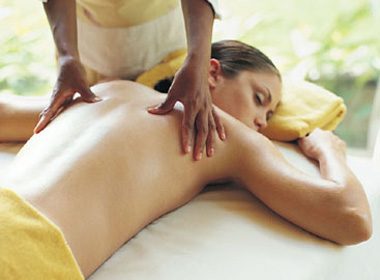
Ice It
As a pain reliever, ice works great. It temporarily blocks pain signals and helps reduce swelling. Several times a day, lay an ice pack wrapped in a towel, or a bag of frozen peas or corn, on the painful area for up to 20 minutes.
After about 48 hours, switch to moist heat to stimulate blood flow and reduce painful spasms. Dip a towel in very warm water, wring it out, then flatten and fold it. Lie on your stomach with pillows under your hips and ankles and place the towel across the painful area. Cover the towel with plastic wrap, then put a heating pad – set on medium – atop the plastic. Leave it on for up to twenty minutes. You can repeat this three or four times a day for several days.

Work It Out
For a simple back-massage aid, stuff several tennis balls into a long sock, tie the end of the sock, and have your partner roll it over your back.
Rub on creams containing methyl salicylate. Derived from the wintergreen shrub, it’s a natural pain reliever related to aspirin. The creams, called counterirritants, stimulate nerve endings in the skin, distracting you from deeper pain. When you use them, you’re also giving yourself a massage – and that hands-on pressure combined with the surface action packs a one-two punch. (Off-limits if you’re also using heating pads or hot compresses on the area.)

Try Pineapple
Three or four times a day, take 500 milligrams of bromelain. Derived from pineapples, this enzyme promotes circulation, reduces swelling, and helps your body reabsorb the by-products of inflammation. Look for a strength between 1,200 and 2,400 MCU (milk-clotting units) or 720 and 1,440 GDU (gelatin-dissolving units). Wait for at least an hour after each meal before taking the bromelain, or it will work mainly in your gut instead of your muscles.

Correct Your Posture
Look for the posture that places the least stress on your back. To do it, stand straight with your weight evenly balanced on both feet. Tilt your pelvis forward, then back, exaggerating the movement. Then settle into the position that feels most comfortable. Now “work your way up” your back, focusing on one area at a time. First concentrate on the area near your waist, then your chest area, and finally your neck and shoulders. Try to feel which position is least stressful and most comfortable. This is the position to maintain when you’re standing, walking, and beginning or ending any exercise.

Check Your Back Pocket
If you’re accustomed to walking around with a wallet in your hip pocket, take it out whenever you’re sitting. Even though it feels like a small lump, it’s big enough to tilt your backside, throwing your spine ever so slightly out of alignment.